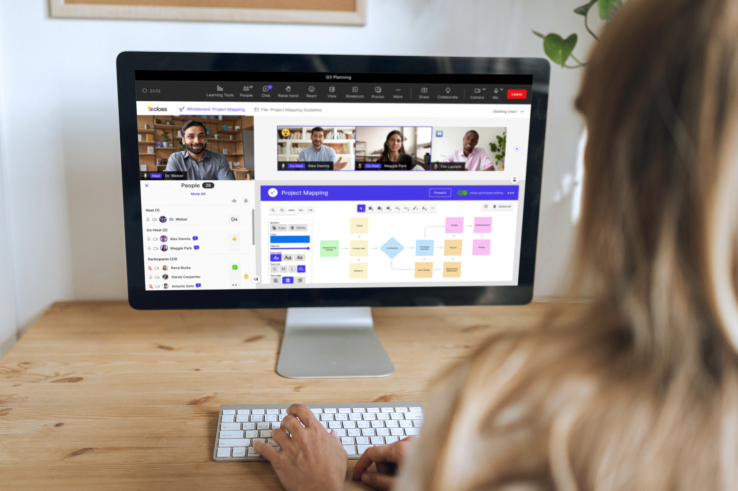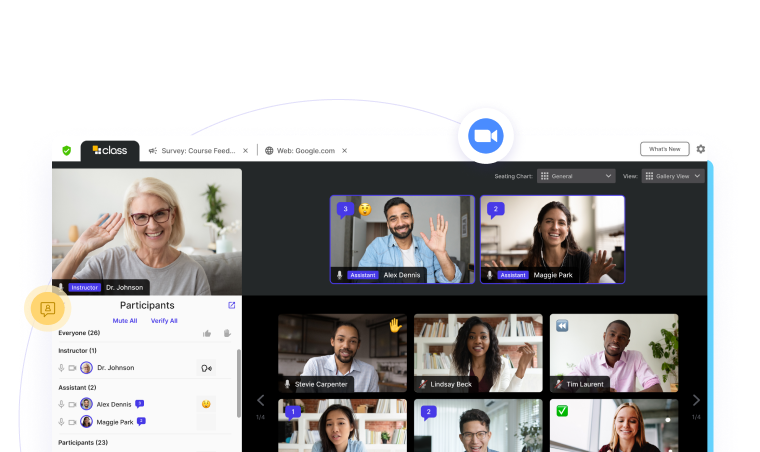
With over a decade of experience in virtual learning and training, Christine has worked with industry-leading platforms including Adobe Connect, Zoom, and now Class Technologies. She brings deep expertise in helping organizations design and deliver impactful, engaging learning experiences that maximize the value of live virtual training.

With over a decade of experience in virtual learning and training, Christine has worked with industry-leading platforms including Adobe Connect, Zoom, and now Class Technologies. She brings deep expertise in helping organizations design and deliver impactful, engaging learning experiences that maximize the value of live virtual training.

Great training can spark careers, strengthen teams, and drive business forward. But for many organizations, delivering that kind of impact feels just out of reach. The intent is there—support employee growth, stay compliant, build internal capabilities—but execution often gets tangled in complexity. It’s tempting to look for a brand-new platform to solve those challenges, especially when existing tools feel limited. But adding new platforms often means more tools to learn, increased costs, and added change management headaches.
Instead of moving teams onto unfamiliar systems, Class enhances the platforms people already use by layering a purpose-built learning experience on top of Zoom and Microsoft Teams. Adding the structure, engagement, and visibility that true learning requires raises the bar for virtual training without slowing down progress.
Adoption is often where training improvements stall. When instructors and learners are asked to switch to a completely new system, hesitation—and even resistance—are common. Most employees already know how to navigate Zoom or Teams, and that familiarity makes a difference.
When training runs through the same tools employees already use to meet, message, and collaborate, it blends seamlessly into their day. There’s minimal mental shift required to engage, and they show up prepared to facilitate, instruct, and learn. That sense of familiarity removes barriers and helps training feel like a meaningful extension of their work.
With budgets under pressure and tech stacks already full, teams are looking for ways to extend the value of existing platforms. Class adds training-specific functionality to the tools you’re already using.
In addition to these practical benefits, there’s also a strategic advantage: because Zoom and Microsoft Teams are already approved platforms in most organizations, many of the necessary security and compliance checks are already in place. For leaders balancing tight budgets and competing priorities, this means training initiatives can move forward quickly and confidently.
Training works best when it’s embedded in the same environment where employees already communicate, collaborate, and get things done. Keeping it within those familiar systems helps reinforce learning as part of everyday work, not a separate task to complete. With Class, training sessions stay connected to the tools employees and administrators use every day.
This alignment helps teams improve training without creating process breakdowns elsewhere. Whether your organization uses Zoom, Teams, or nearly any LMS, Class is designed to complement that foundation.
Procurement processes can stall even the best training initiatives. When you add an entirely new platform to the stack, legal, IT, finance, and compliance teams all get involved, which can slow down momentum.
Adding Class to Zoom or Teams can help to clear those hurdles:
Enhancements that build on familiar tools are easier to justify, especially when they support company-wide priorities like efficiency, alignment, and growth.
In many organizations, instructors are expected to lead high-impact sessions using tools designed for meetings, and not purpose-built for learning. There’s little structure to guide engagement, few tools to measure success, and no clear feedback on what’s resonating with learners.
To improve the instructor experience, organizations need to provide tools that offer more control during sessions and greater visibility into what’s working.
Creating a meaningful learning experience is essential, but it’s just as important to support the people leading those sessions. Instructors need tools that help them understand what’s working, where learners are disengaging, and how to improve over time. Equipping facilitators with that level of insight is key to making training more effective and impactful.
Organizations invest in training and L&D to drive real outcomes aligned to business goals, whether that’s advancing strategic initiatives, improving compliance, or building capabilities that fuel growth. The challenge is that regular meeting platforms aren’t built to support those goals. To turn training into a driver of strategic initiatives, you need solutions that can:
At the end of the day, the real value comes from turning everyday collaboration tools into engines for growth. By building on Zoom or Teams with Class, organizations can deliver the kind of outcomes and strategic initiatives that standard meeting platforms simply weren’t designed to support.
Improvements don’t have to come from an entirely new platform. Often, the most sustainable progress starts with making better use of what’s already working. When your organization builds on top of Zoom or Microsoft Teams with Class, you open the door to smarter, more effective virtual training, with far less disruption.
Ready to take a closer look? Schedule a personalized walkthrough and explore how Class helps your team deliver better virtual training using tools your workforce already knows and relies on.
Q: What does it mean to layer on top of Zoom and Microsoft Teams?
A: Layering on top of Zoom or Microsoft Teams means adding purpose-built features for learning—like engagement tools, instructor controls, structured workflows, and analytics—without replacing the core video platform. Class uses your organization’s existing Zoom or Teams infrastructure as the foundation, then enhances it with functionality designed specifically for learning. This approach lets you improve the training experience while avoiding the disruption of switching platforms.
Q: Can Class integrate with our existing LMS?
A: Yes. Class is designed to work within your existing ecosystem and integrates with most major learning management systems (LMSs). Training sessions can be scheduled, delivered, and tracked using the same infrastructure you already rely on, making it easier to manage and scale improvements across the organization.
Q: What are the benefits of using Class with Zoom or Microsoft Teams instead of adopting a standalone training platform?
A: Using Class with Zoom or Microsoft Teams reduces change management challenges, avoids duplicate spend on standalone video platforms, and accelerates procurement since those tools are often already approved by IT and finance. It also helps maintain a consistent employee experience by embedding training into tools employees use every day.

With over a decade of experience in virtual learning and training, Christine has worked with industry-leading platforms including Adobe Connect, Zoom, and now Class Technologies. She brings deep expertise in helping organizations design and deliver impactful, engaging learning experiences that maximize the value of live virtual training.

With over a decade of experience in virtual learning and training, Christine has worked with industry-leading platforms including Adobe Connect, Zoom, and now Class Technologies. She brings deep expertise in helping organizations design and deliver impactful, engaging learning experiences that maximize the value of live virtual training.
Get our insights, tips, and best practices delivered to your inbox

Sign up for a product demo today to learn how Class’s virtual classroom powers digital transformation at your organization.

Features
Products
Integrations